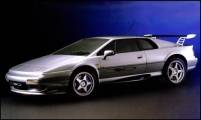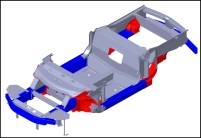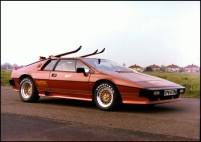Esprit Replacement to Boast 400 to 500 HorsepowerLotus, a brand that was on the verge of bankruptcy not so long ago, has vowed to challenge the strongest name in sports cars today,
 |
| The new Esprit should look something like this, with a convertible variant also promised. (Photo: Lotus Cars) |
Porsche. How? By reintroducing one of the most hallowed names in sport car history: Esprit.
Yes. You read that right. Lotus, swelled with the success of its wildly popular Elise and Exige models, has announced that it will reenter the supercar arena with what they are calling the "Esprit replacement". Promising incredible performance figures as well as 911-rivalling drivability, the new supercar, which
 |
| The last generation Esprit was adorned with an amalgamation of boy racer scoops and wings, the new model won't be. (Photo: Lotus Cars) |
has yet to be officially named (apparently the jury is still out on the name "Esprit"), will use the traditional Lotus formula of featherweight construction to achieve its blistering numbers.
Expected to start production at Lotus' Hethel facility by Spring 2008, the new car will use a mid-mounted V8 for propulsion. The V8 in question isn't yet known, but rumors abound that the powerplant is a naturally aspirated 5.0L V8 sourced from BMW (as used in the last generation BMW M5) and tuned to provide over 400 horsepower in the Esprit, leaving room for a top tier turbo model that would have something over 500 horsepower. Conversely,
 |
| New Lotus supercar's underpinnings show the corner nodes in red and spars in blue. Variable floorpans and spars make the architecture incredibly adaptable. (Photo: Lotus Cars) |
other sources cite a Toyota-sourced twin turbo V8, also providing around 500 horsepower. Either way, with an alleged curb weight of approximately 2,900 pounds the new supercar should make short work of its German nemesis.
The car's light overall weight comes from what Lotus is calling its "Versatile Vehicle Architecture." Four years in development, VVA uses "high pressure die-cast corner nodes" as their basis, and then connects these corner nodes with aluminum spars of varying lengths. The corner nodes, being the strongest part of the frame, support the suspension and serve to redirect impact forces away from the passenger compartment in the event of a collision. Since the rest of the car is simply a network of node connectors, numerous different platforms and body styles, ranging from mid-engined supercars to
 |
| A silver-screen star, the Esprit was James Bond's transport in "The Spy Who Loved Me" and made a famous appearance picking up a prostitute played by Julia Roberts in "Pretty Woman." (Photo: Lotus Cars) |
seven-seater SUVs can use the same nodes. Through such node sharing, development costs are cut as each new model no longer requires extensive testing and retooling, and the result is that only 50,000 cars need to be built per year to turn to a profit. That, needless to say, is helpful to a niche manufacturer like Lotus, which can turn a profit making far less cars than a mainstream manufacturer. And when the car's panels are riveted and bonded together, VVA provides an incredibly stiff platform, which in turn allows the precision suspension tuning Lotus is known for, as well as the nice side effect that Lotus can, and will, lop the roof off of their new Esprit.






